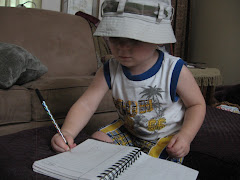1. Blumenthal, Karen. Six Days in October: The Stock Market Crash of 1929. New York: Atheneum Books for Young Readers, 2002.
2. Overview. Blumenthal takes readers through the first six days of the stock market crash of 1929. She opens with an Introduction that covers the 1920s and goes up to Wednesday night, October 23, 1929, when rumors started to circulate of problems with the market. Blumenthal then does an in-depth coverage of Black Thursday through Black Tuesday - October 24-29, 1929, by sequentially describing the events causing and following the crash. A section on the immediate aftermath of October 30, 1929, is then followed by an Epilogue describing the effects from 1930 through 1933.
3. Critical Analysis. Many people, including myself, do not choose to read nonfiction for enjoyment. However, this book goes on my list of one of my best reads of this year. Some things I love about this book:
A. I know very little about the ins and outs of the stock market, but Blumenthal's narrative made a very complicated concept mostly understandable. (There are still some places where I'm fuzzy, but that's probably to be expected from someone who doesn't even do the home budget.) Her tone is informative and geared toward younger readers (middle and high schoolers). The narrative is sequential and logical. The style is energetic and helps readers feel the urgency of what was happening during the crash.
B. There are tons of support materials. Reproductions of documents, cartoons, advertisements, news clippings and photographs again help readers understand a very complicated concept. The scope seems just right - the focus is on the six major days with the few years preceeding and following being discussed enough to provide context.
C. Text boxes that are separate from the narrative explain vocabulary terms/concepts in concrete ways. Terms which have text box explanations include: stock, stock exchange, bull and bear markets, opening gong, Dow Jones Industrial Average, bonds, brokerage house, plungers and pools, and stock split among others provide additional support for understanding terms that are used throughout the narrative.
D. Informational books can become dated very quickly. However, because this informational book is about a historical event, it will not lose it's meaningfulness. The information will not go out of date, and readers can gain better understanding of a major event in the history of the United States. Understanding what happened in the past can help us understand the future as well. As the stock market continues to experience major crashes, such as the ones in 1987 and 2008, understanding the original crash in 1929 can help us make sense of subsequent crashes that occur during our lifetime.
One thing that rather surprised me about the book is the way Blumenthal cites her sources. Rather than internal citations or footnoted references, she presents a simple list of references, chapter by chapter, at the end of the book. As Booklist noted, "Students using this for research may be frustrated by the source citations, which appear as an appended, generalized chapter-by-chapter listing of materials consulted rather than as specific notes that correspond to text passages." It is impossible to tell what information came from where without looking up every source. But this is the only weakness I notice in the book.
I'm old enough to have had relatives who lived during the stock market crash of 1929. So reading about the actual facts of the events is interesting as I have heard grandparents describe what they remember as young people. This was an event where they remembered where they were on October 24, 1929, much like 9/11 is for us today or the assassination of Kennedy for the generation preceeding mine. The information presented in Blumenthal's book is a great addition to my knowledge as an adult. For young people, particularly middle and high schoolers, this would be a great book to extend their learning after they see what their textbooks say on the topic. Six Days in October is a Robert F. Sibert Honor Book, an honor bestowed on the best informational literature for children each year.
I have already recommended this book to others. Interestingly, the others I've recommended it to are all adults. The topic is so specific that I'm not sure I would think to recommend it to my high school students as just a general suggestion unless the topic came up. However, with a little thought and a good book talk, the topic might be of interest to young people who love to read nonfiction. Unfortunately, my school library does not have this book, so I will not be able to try out my theory any time soon. But I personally feel much more informed for having read this book myself.
4. Review Excerpts.
Publishers Weekly: "This fast-paced, gripping (and all-too-timely) account of the market crash of October 1929 puts a human face on the crisis. Blumenthal ably chronicles the six-day descent and exposes the personalities, backroom machinations and scandals while debunking several popular myths about the crash (e.g., that it caused mass suicide and the Great Depression). A compelling portrait of a defining moment in American history."
Booklist: "But this still offers a riveting history, along with the basic terminology needed to grasp the events and to draw parallels between the volatile, sometimes corrupt, market of 1929 and the market today."
GUEST POST: Chris Baron on SPARK
7 months ago







